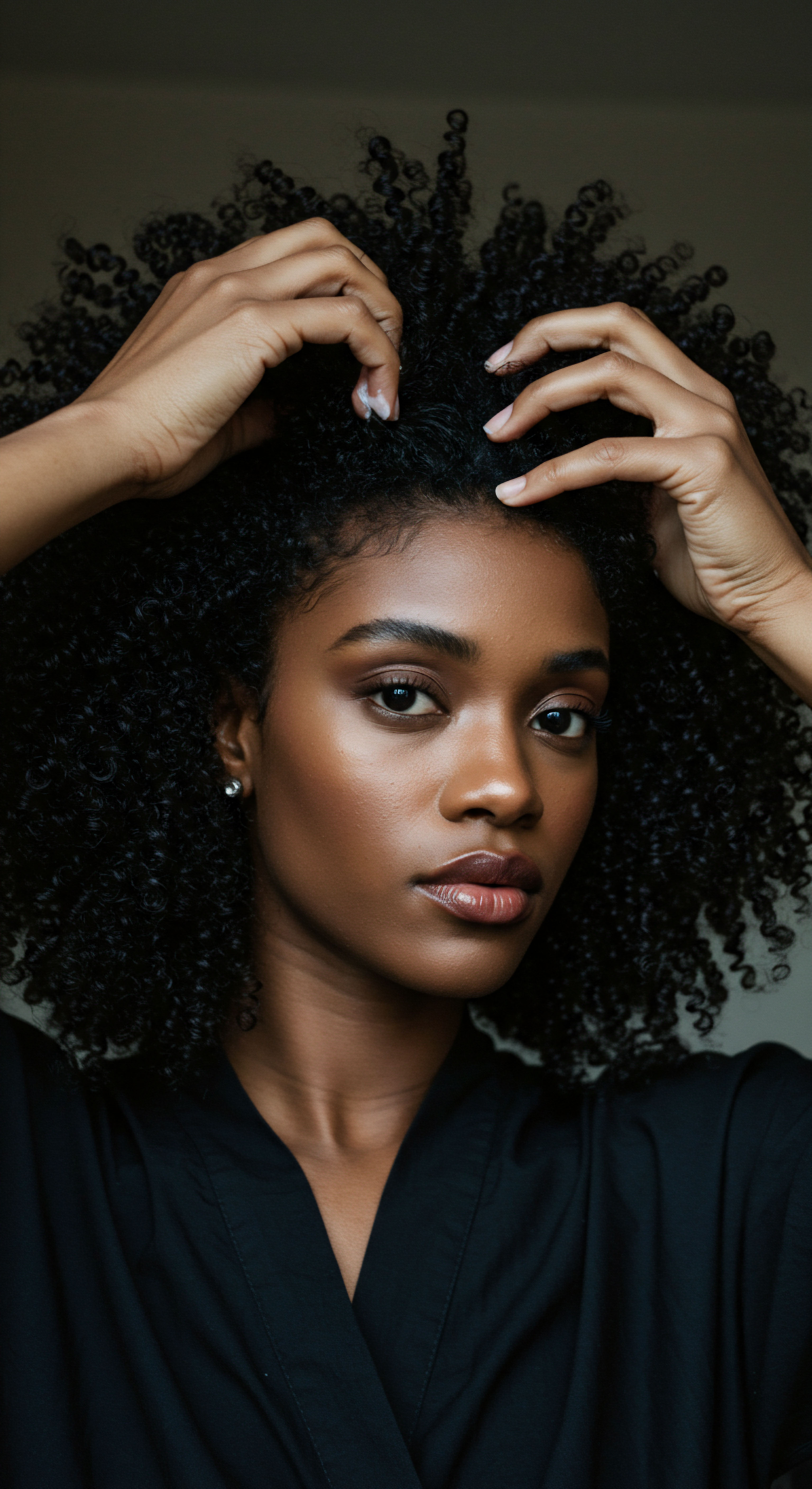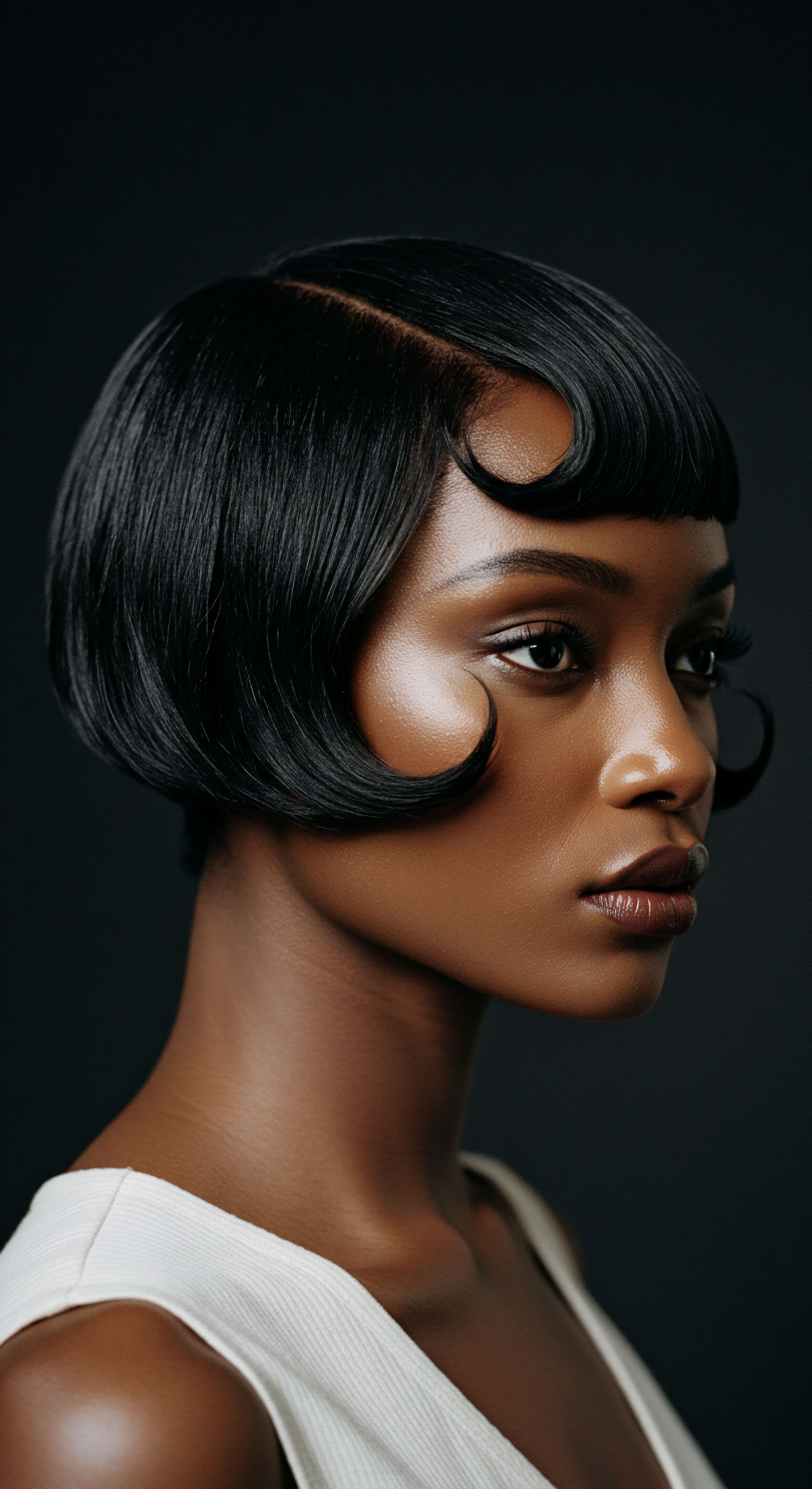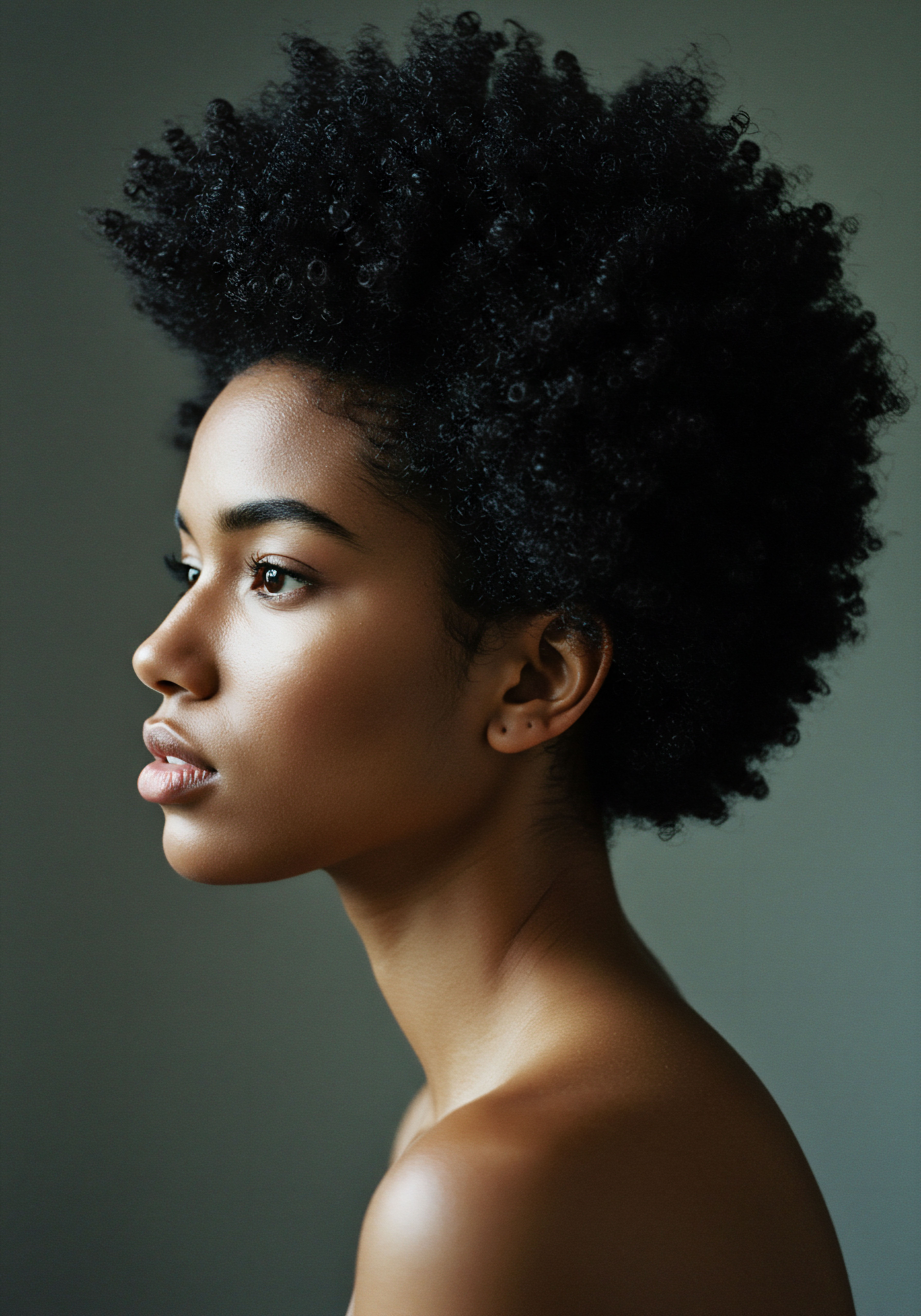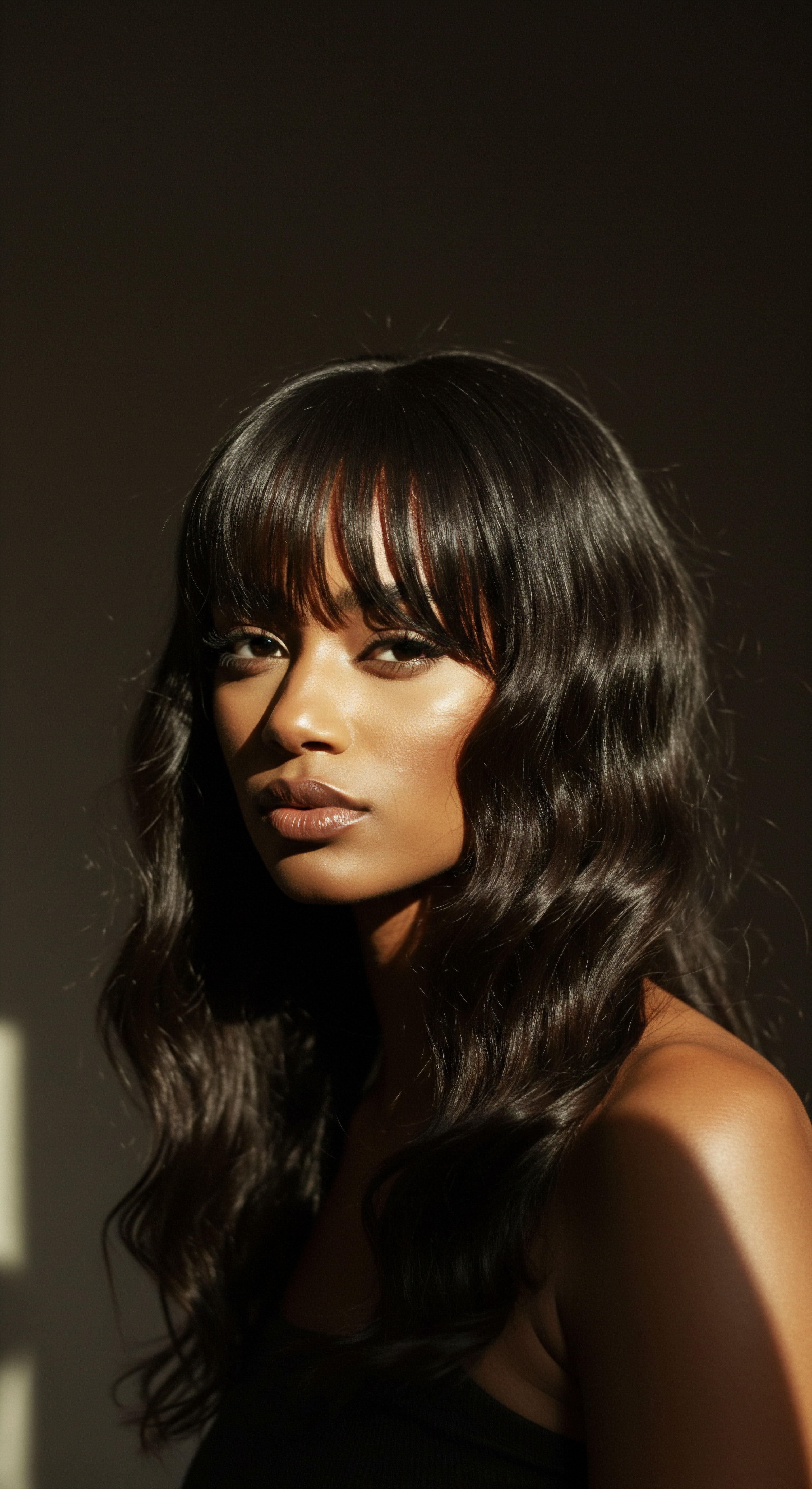
Roots
The quiet hum of curiosity often leads us to peer closer at the things we encounter daily, perhaps even our own strands. We reach for a cream, a gel, a serum, expecting a certain response, a familiar transformation. Yet, sometimes, our hair surprises us, acting in ways that defy our expectations.
This subtle divergence, this whisper of difference, points to a deeper truth ❉ the outward presentation of our hair is inextricably tied to its hidden architecture. Understanding how a product interacts with the internal workings of each strand is not merely a scientific pursuit; it is a gentle unveiling of hair’s inherent wisdom, a way to move beyond surface-level care into a profound dialogue with our coils, curls, and waves.
At its core, hair is a complex biological marvel, a protein filament that springs from the scalp, shaped by genetic blueprints and influenced by a lifetime of experiences. To truly comprehend how a product leaves its mark, we must first journey inward, exploring the microscopic landscapes that determine so much of our hair’s behavior.

The Hair Strand Unveiled
Each individual hair, a seemingly simple filament, holds a layered universe within. From the outermost shield to the innermost core, these structures dictate how moisture enters and leaves, how strength is maintained, and how external applications perform their work.
- Cuticle ❉ The outermost layer, a protective armor of overlapping, flat, scale-like cells. Think of these as tiny shingles on a roof. Their condition, whether tightly sealed or raised, profoundly influences how hair receives and retains moisture and product. When healthy, these scales lie flat, reflecting light and offering a smooth surface. When compromised, they lift, leading to a rougher feel and increased vulnerability.
- Cortex ❉ Lying beneath the cuticle, this is the main body of the hair shaft, accounting for the majority of its mass. It is here that the hair’s strength, elasticity, and color reside. The cortex comprises bundles of keratin proteins, arranged in a specific way, and contains the melanin pigments that give hair its hue.
- Medulla ❉ The innermost core, often absent in finer hair types, is a loosely arranged central channel. While its precise function remains an area of ongoing study, it is thought to contribute to hair’s volume and overall mechanical properties.
The condition of these layers, particularly the cuticle and cortex, forms the initial dialogue between hair and product. A product’s ability to soften, strengthen, or define is fundamentally shaped by its capacity to interact with these internal components.
The outermost cuticle, the robust cortex, and the central medulla collectively orchestrate hair’s response to applied treatments.

Keratin and Its Chemical Bonds
The fundamental building block of hair is Keratin, a fibrous protein. This protein is not a singular entity but a complex arrangement of amino acids held together by various chemical bonds. These bonds are the invisible architects of hair’s shape, resilience, and elasticity.
There are three primary types of bonds within the hair’s protein structure:
- Disulfide Bonds ❉ These are the strongest of the three, forming between sulfur atoms in cysteine amino acids. Disulfide bonds are permanent and largely responsible for the hair’s inherent shape, curl pattern, and stability. Chemical treatments, such as perms or relaxers, work by intentionally breaking and reforming these bonds to alter the hair’s configuration.
- Hydrogen Bonds ❉ Weaker and temporary, these bonds are susceptible to water. When hair gets wet, hydrogen bonds break and reform as the hair dries, allowing for temporary changes in shape, like those achieved with heat styling. They contribute significantly to hair’s elasticity.
- Salt Bonds ❉ Also temporary, salt bonds are formed between positive and negative ends of amino acid chains. They are sensitive to pH levels, and an imbalance can disrupt them.
The relative abundance and arrangement of these bonds vary across different hair types, especially between straight and textured hair. For instance, curly and coily hair typically possesses a higher density of disulfide bonds, contributing to its pronounced curl patterns. This inherent structural difference means that products designed to affect hair shape or strength will interact with these bonds in distinct ways, necessitating a tailored approach to care.

Does Melanin Play a Role in Product Interaction?
Beyond structural proteins, the hair’s internal composition also includes Melanin, the pigment responsible for hair color. Melanin is found primarily within the cortex. While its most obvious role is pigmentation, melanin also holds protective qualities.
Melanin exists in two main forms ❉ eumelanin (dark brown to black) and pheomelanin (red and yellow tones). The concentration and distribution of these pigments not only determine color but also influence how hair responds to external stressors, including UV radiation. Darker hair, rich in eumelanin, often exhibits greater resilience to UV damage.
While direct interactions between melanin and product absorption are not the primary focus of most studies, the presence and type of melanin can indirectly affect how products are perceived to work, particularly in relation to color protection or overall hair health. For example, products aimed at color retention often consider melanin’s role in absorbing light and protecting against fading.

Ritual
As we move from the unseen foundations of hair to the daily gestures of care, a deeper understanding of internal structures becomes our guiding light. The application of a conditioner, the selection of a styler, the very rhythm of our wash day – these are not mere habits but thoughtful engagements with our hair’s inherent design. Each ritual, whether a quick detangling session or a leisurely deep conditioning treatment, finds its true effectiveness rooted in how well it harmonizes with the hair’s unique internal architecture. This section explores how these everyday practices, informed by the science of the strand, shape our hair’s vitality and responsiveness.

How Does Porosity Influence Product Adherence?
The concept of Porosity stands as a primary determinant of how hair responds to products. Porosity describes the hair’s capacity to absorb and retain moisture, a characteristic directly tied to the condition of the cuticle layer.
When the cuticle scales lie flat and tightly sealed, hair exhibits Low Porosity. This hair type can be slow to wet, and products may sit on the surface rather than penetrating easily. Conversely, when cuticle scales are raised or compromised, hair has High Porosity.
This hair absorbs water quickly but also loses it just as rapidly, often feeling dry and appearing frizzy. Damage from chemical treatments, heat styling, or even mechanical manipulation can elevate porosity.
Consider the impact of product formulation:
- Low Porosity Hair ❉ Benefits from lighter, more liquid-based products that can readily slip past the tightly closed cuticles. Applying heat (such as a steamer or warm towel) during deep conditioning can help gently lift the cuticle, allowing beneficial ingredients to enter the cortex.
- High Porosity Hair ❉ Requires heavier creams, butters, and oils to seal the lifted cuticles and prevent moisture loss. Protein treatments can also assist by temporarily filling gaps in the compromised cuticle, offering a smoother surface and improved strength.
The interplay between product and porosity is a dance of give and take. A product’s effectiveness is not solely about its ingredients, but about how those ingredients can actually reach the intended internal layers of the hair shaft.
Hair’s porosity, governed by cuticle integrity, dictates how readily products penetrate and how effectively moisture is retained.

Product Penetration and Molecular Size
The internal structures of hair also dictate the depth to which a product’s ingredients can travel. The hair shaft, while absorbent, is also selective. The size of the molecules within a product plays a significant role in their ability to cross the cuticle and reach the cortex.
Smaller molecules, such as certain hydrolyzed proteins or amino acids, have a greater likelihood of penetrating the cuticle and entering the cortex, where they can contribute to internal repair and strengthening. Larger molecules, like some conditioning agents or film-forming polymers, tend to remain on the hair’s surface, providing external smoothing, shine, and protection.
This distinction is particularly relevant for textured hair, which, due to its unique structural characteristics like a more elliptical cross-section and potentially uneven distribution of internal components, can present distinct challenges for uniform product distribution.
| Molecule Size Small (e.g. amino acids, some hydrolyzed proteins) |
| Primary Interaction Zone Cortex (internal) |
| Hair Benefit Internal repair, strength, elasticity |
| Molecule Size Medium (e.g. some oils, smaller polymers) |
| Primary Interaction Zone Cuticle, outer cortex |
| Hair Benefit Cuticle smoothing, light conditioning |
| Molecule Size Large (e.g. heavy butters, film-forming polymers) |
| Primary Interaction Zone Surface (external) |
| Hair Benefit Sealing, shine, frizz control, protection |
| Molecule Size Understanding ingredient molecular weight helps in selecting products for targeted hair benefits. |
Consider deep conditioning treatments. Those formulated with smaller, reparative peptides aim to rebuild strength from within, while those with larger, emollient ingredients focus on surface softness and detangling.

The PH Balance and Hair Integrity
The pH of a product is another silent, yet powerful, influence on how hair’s internal structures respond. Hair and scalp maintain a slightly acidic pH (hair around 3.7, scalp around 5.5). This natural acidity helps keep the cuticle scales tightly closed, contributing to smoothness and protection.
Products with an alkaline pH (above 7) can cause the cuticle scales to lift, making the hair more vulnerable to damage and increasing its porosity. This is why many shampoos, which need to cleanse effectively, are often slightly alkaline, and why conditioners, designed to smooth and seal, are typically acidic.
Using products that respect the hair’s natural pH helps maintain the integrity of the cuticle, thereby safeguarding the cortex within. A product that supports the hair’s acidic mantle assists in keeping the cuticle flat, reducing friction, and promoting shine. Conversely, repeated exposure to highly alkaline products can lead to cumulative damage, making hair feel rougher, appear duller, and become more prone to breakage.

Relay
To truly comprehend how our hair responds to the applications we choose, we must move beyond simple observations and delve into the deeper currents that flow beneath the surface. This section explores the more complex, interconnected ways in which hair’s internal architecture, its very composition, dictates its interaction with products. Here, science meets lived experience, revealing why certain approaches yield profound benefits while others may fall short. We consider not only the physical barriers but also the subtle chemical dialogues occurring within each strand, influenced by factors often overlooked in conventional hair discussions.

How Do Disulfide Bonds Influence Product Efficacy?
The disulfide bonds, those robust links within the keratin proteins of the cortex, are central to hair’s intrinsic shape and mechanical strength. Their distribution and integrity profoundly influence how hair responds to a wide array of products, especially those designed for chemical alteration or intensive repair.
Consider chemical treatments like relaxers or perms. These processes intentionally disrupt disulfide bonds to permanently reshape the hair. The effectiveness of these treatments, and the subsequent need for specific conditioning and repair products, is directly tied to the manipulation of these bonds. Products that follow such treatments often aim to stabilize newly formed bonds or provide protein building blocks to support the hair’s altered structure.
Beyond chemical services, the natural state of disulfide bonds in textured hair presents unique considerations. Curly and coily hair typically exhibits a higher density of disulfide bonds, which contribute to its distinctive helical configuration. This structural reality means that products must interact with a denser, more complex internal network.
For instance, some research suggests that the unique cortical structure of textured hair, with its highly curved and coiled nature, can lead to uneven distribution of external materials. This physical characteristic can create distinct diffusion zones, impacting how uniformly products penetrate the cortex compared to straight hair.
This uneven distribution, rather than simply porosity, can be a significant factor in product efficacy for highly textured strands. It means that even a product with excellent reparative ingredients might struggle to deliver those ingredients uniformly across the entire length and breadth of a tightly coiled strand, potentially leading to areas of both enhanced benefit and relative neglect. This nuanced understanding pushes beyond generalized notions of “damaged hair” to consider the specific biomechanical realities of textured hair.

The Role of Internal Lipids in Product Response
While external lipids, like sebum, are widely acknowledged for their role in hair health, the internal lipids within the hair shaft also hold significant sway over how products perform. These lipids, present in the cuticle and cortex, act as a natural barrier, influencing water uptake and overall hair permeability.
Interestingly, research indicates that Afro-textured hair, despite often being perceived as dry, can have a higher overall lipid content compared to European and Asian hair types. Some studies even suggest that Afro-textured hair may contain 1.7 times higher internal lipid content than other ethnic groups. However, the distribution and specific composition of these lipids can vary. For example, some studies suggest that while Afro-textured hair has high apolar lipid levels, leading to lower radial swelling in water, it can also exhibit lower hydration levels overall, indicating a need for targeted moisture.
This complex lipid profile impacts product response in several ways:
- Moisture Retention ❉ The internal lipid barrier helps to regulate how quickly water enters and leaves the hair. Products designed to seal in moisture, such as heavy creams and oils, work in concert with these internal lipids to create a more effective barrier against dehydration.
- Ingredient Penetration ❉ The lipid composition can influence the path and speed of ingredients through the cuticle. Certain product components, particularly those with a lipophilic (oil-loving) nature, may interact differently with the hair’s lipid layers, affecting their ability to reach the cortex.
- Mechanical Properties ❉ Lipids contribute to the hair’s flexibility and strength. Products that aim to improve elasticity or reduce breakage often contain ingredients that support or replenish these vital internal lipid structures.
The nuanced interplay of internal lipid content and distribution highlights why a “one-size-fits-all” approach to moisturizing or strengthening products may not yield optimal results across all hair types, particularly those with distinct internal lipid profiles.

Can Hair’s Cross-Sectional Shape Affect Product Distribution?
Beyond the chemical bonds and lipid layers, the very geometry of the hair strand itself, specifically its cross-sectional shape, can subtly yet significantly affect how products are distributed and absorbed. Straight hair typically possesses a round cross-section, while wavy hair tends to be oval, and curly to coily hair can range from oval to highly elliptical or flattened.
This morphological difference is not merely cosmetic. The more elliptical or flattened the cross-section, particularly in tightly coiled hair, the more complex the surface area becomes for product application. This can influence:
- Uniform Coating ❉ Achieving an even coating of a product, especially thicker creams or gels, can be more challenging on highly elliptical strands. The product may concentrate in the curves or crevices, leading to uneven distribution.
- Absorption Pathways ❉ The physical shape can influence how ingredients move across the cuticle and into the cortex. Some research suggests that the unique cortical structure of textured hair creates “distinct diffusion zones,” leading to an irregular distribution of external materials. This means that even if a product contains small molecules designed to penetrate, their journey might not be uniform across the entire strand.
- Friction and Breakage ❉ The flattened shape, combined with the natural coiling, can increase friction between strands, making detangling more difficult and potentially leading to breakage. Products designed to reduce friction, such as slippery conditioners, become even more critical in this context.
A study by Milbon Co. Ltd. revealed that curly hair often has weaker cuticle adhesion and lower hair strength compared to straight hair. They also confirmed that the amount of glycoprotein, a substance thought to aid cuticle adhesion, was lower in curly hair.
This suggests that the structural integrity at the cuticle level, potentially influenced by cross-sectional shape and internal components, can predispose certain hair types to greater vulnerability and influence how products aimed at strengthening or smoothing perform. This finding underscores the need for products that not only coat the surface but also work to reinforce the internal adhesion and strength of the hair fiber.

Reflection
The journey into hair’s internal structures reveals a profound truth ❉ our strands hold stories, not just of styling and trends, but of intricate biological design and ancient heritage. Every application of a product, every gentle touch, is a conversation with these hidden layers. Understanding the language of the cuticle, the resilience of the cortex, and the silent strength of chemical bonds allows us to move beyond fleeting trends and toward a more intuitive, respectful relationship with our hair. It is a dialogue that honors both science and self, reminding us that true hair wellness springs from a place of deep knowing, where care is tailored, intentional, and profoundly personal.

References
- Milbon Co. Ltd. (2024). Microscopic Observation of Hair Structure for Hair Types Around the World by Inborn Curl Shape.
- Wood, M. & Leyden, M. (n.d.). Chemistry of Wellness ❉ Hair and Hair Care. UVA ChemSciComm.
- Gaines, M. et al. (2023). Coils & Curls ❉ A Mathematical Tapestry of Black Hair. Algorithmic Pattern.
- Lee, Y. & Lee, W. (2023). Hair Lipid Structure ❉ Effect of Surfactants. MDPI.
- Bhushan, B. & Sachar, N. (2010). Nanomechanical Characterization of Human Hair. Journal of Applied Physics.
- Robins, D. J. (2010). The chemistry of hair. Royal Society of Chemistry.
- Dias, M. F. R. G. (2015). Hair Cosmetics ❉ An Overview. International Journal of Trichology.
- Ruetsch, S. B. et al. (2000). The effect of water on the mechanical properties of human hair. Journal of Cosmetic Science.
- Syed, A. N. et al. (2002). Correlating porosity to tensile strength. Cosmetics & Toiletries.
- Davis-Sivasothy, A. (2011). The Science of Black Hair. Saja Publishing Company.
- Draelos, Z. D. (2011). Hair Care ❉ An Illustrated Dermatologic Handbook. Springer.
- Robbins, C. R. (2012). Chemical and Physical Behavior of Human Hair. Springer.
- Popescu, C. & Hocker, H. (2009). Hair and Hair Care. Cosmetics & Toiletries.
- Marsh, J. M. & R. L. R. (2019). The chemistry of hair color and its interaction with the hair fiber. Journal of Cosmetic Science.
- Pugh, J. E. et al. (2020). Defying Damage ❉ Understanding Breakage in Afro-textured Hair. Cosmetics & Toiletries.